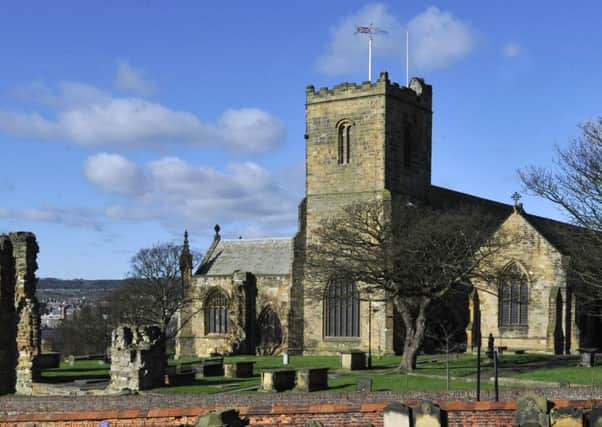Nostalgia: Great plague returns with a vengeance


Sir Richard’s fears were confirmed when, at the beginning of October, news was posted that no courts would sit at Scarborough after Michaelmas “because the town was visited with the great plague”.
The onset of winter seems not to have brought any relief to the poor people of Scarborough. On November 6, 1624, Robert Dawson, a dyer, aged 36, and Leonard Beardsall, a labourer, aged 40, and their wives were accused of going abroad at night to steal two dead sheep in Seamer’s fields “without Weapnes riggate”. To the charge they pleaded “necessity & hunger” which drove them to it “in this tyme of gods visitation”.
Advertisement
Hide AdAdvertisement
Hide AdSo great was Scarborough’s distress that the North Riding magistrates, meeting at Thirsk in October, ordered that the three neighbouring wapentakes, Whitby Strand, Pickering Lythe and Ryedale, should pay £10 a week to the town “so grieved with sicknes”.
Conscious of the deep damage that the plague would do to Scarborough’s trade, in February 1625 the borough’s two bailiffs, Paul Peacock and Thomas Foord, wrote to the lord mayor of York to assure him that the infection had passed, “nott any dying of late”. He could therefore safely buy fish or any other commodity from Scarborough. Appropriately, the message was carried to York by that city’s “purveyor of fysh”.
However, it was soon evident that the plague had been only subdued by winter temperatures, not extinguished. In the spring of 1625 Scarborough’s markets were again closed and, much to the grief of its traders, Whitby was free of infection and taking commercial advantage. Sir Richard Cholmley was accused of deliberately exaggerating Scarborough’s plight in order to line his own pockets.
As the temperature rose in Scarborough, so did the number of recorded deaths there. It was not until the summer of 1626 that the epidemic subsided and by then it had spread inland to the two Aytons, Wykeham and even Malton. The last place was so closely quarantined that Scarborough’s bailiffs were asked to leave fish and other provisions at “the bridge end in Norton (that as yet thankes be to god stands cleare)”. It was promised that the “bringers” would not be in any danger of infection.
Advertisement
Hide AdAdvertisement
Hide AdScarborough’s authorities reacted vigorously to the epidemic of 1624-6. Eight “overseers”, two from each of the four Quarters, Undercliff, Oldborough, St Mary’s and Newborough, were appointed by the Common Hall “to garde the quarters in the infeccion tyme”. None of the 44 members was exempt from day or night duty. Suspected victims were confined to their homes and fed by the overseers who also collected weekly rates from the healthy.
But the number of the infected was too many for the overseers and constables. In June 1626 it was decided to build a pesthouse for the town. The hospital of St Nicholas, in the past a refuge for lepers, was now ruin, so that a new lodge was needed on the edge of the residential borough. Tintinholmes, somewhere between Peasholm beck to the north and castle holmes to the south, already belonged to the Corporation and here a wooden pesthouse, 30 feet long, was constructed. The cost of the new building and the upkeep of its inmates was borne by the 44 in proportion to their status in the Common Hall.
But the worst was yet to come. Plague returned to Scarborough in 1635, reached a climax in 1636, and faded away only slowly until the spring of 1638. September 1636 was the deadliest month: on one day alone, the 20th, five victims were buried at St Mary’s. In the two years from March 1635 until April 1637, recorded burials (178) exceeded recorded baptisms (170). In the country’s most populous centres, such as London, Bristol and York, plague mortality was highest among the poorest who lived in the shanty suburbs outside the walls. But in Scarborough rich and needy lived side by side and the infection was indiscriminate. Martin Atmar, a former bailiff, lost a baby son; John Rosdale, a master baker, buried two daughters within a fortnight.
Once again Scarborough had to be quarantined. According to the incomplete records of the Court of Pleas, between October 1636 and November 1637, 47 ships’ masters took the oath before the bailiffs that their crews and cargoes were entirely free of infection. Once again, special “watchmen” were chosen to serve under the borough’s constables. They too swore oaths that they would keep infected persons in their homes, shops or ships and relieve them “with needfull and necessary wantts for there presentt maintinance with meate & drinck, water or the like”.
Advertisement
Hide AdAdvertisement
Hide AdWhether the pesthouse in Tintinholmes was full of the sick or had been demolished since 1626 is not recorded, but in March 1638 another lodge was ordered to be built “in the holmes”. By September of that year 20 shillings out of the town’s poor fund had been collected “for the lodge people”.
During this particular outbreak, it seems that Newcastle and Hull were very badly affected. As late as January 1638 there was a voluntary appeal in Scarborough “for releefe of Hull”.
Finally, during the Civil War, when the town was governed by martial law, there is surviving evidence of a serious epidemic. In June 1645, as Parliament’s army besieged the castle, 547 of its soldiers were paid a shilling a day “for washing the infected houses”; and the following year there is a reference to another pesthouse at Driple Cotes on the south cliff, site of what became the Crown hotel two hundred years later.